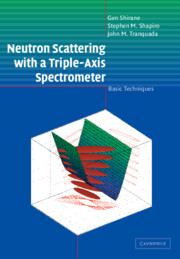Book contents
- Frontmatter
- Contents
- Preface
- 1 Introduction
- 2 Scattering formulas
- 3 Elements of a three-axis instrument
- 4 Inelastic scattering and the resolution function
- 5 Phonons and magnons
- 6 Spurious peaks
- 7 Bragg diffraction
- 8 Polarized neutrons
- Appendix 1 Neutron scattering lengths and cross sections
- Appendix 2 Crystallographic data
- Appendix 3 Other useful tables
- Appendix 4 The resolution function for a triple-axis neutron spectrometer
- Index
Preface
Published online by Cambridge University Press: 19 August 2009
- Frontmatter
- Contents
- Preface
- 1 Introduction
- 2 Scattering formulas
- 3 Elements of a three-axis instrument
- 4 Inelastic scattering and the resolution function
- 5 Phonons and magnons
- 6 Spurious peaks
- 7 Bragg diffraction
- 8 Polarized neutrons
- Appendix 1 Neutron scattering lengths and cross sections
- Appendix 2 Crystallographic data
- Appendix 3 Other useful tables
- Appendix 4 The resolution function for a triple-axis neutron spectrometer
- Index
Summary
The triple-axis spectrometer (TAS) remains arguably the most versatile instrument used for neutron scattering studies, and research using TASs has been of fundamental importance to many areas of condensed-matter science. The power provided by the flexibility of the TAS brings with it some challenges, and determining the optimal conditions for a particular experiment (often referred to as “finding the window”) is a significant one. Various experimental pitfalls have also been identified over the years.
For 32 years (1965–96), triple-axis spectrometers at Brookhaven's High Flux Beam Reactor (HFBR) were the main tools of our Neutron Scattering Group. During that time, many basic techniques for both how and how not to perform experiments were recorded in group research memos. When new post-docs joined the group, they were expected to familiarize themselves with these memos; in addition, they were given a substantial list of references, including numerous research articles, to look up and read. The present book is intended to present the collection of basic techniques in a more-or-less coherent fashion. Besides graduate students and post-docs, we hope that the information presented here will also be useful to experienced researchers who are new to neutron scattering.
Of course, this book would have no purpose if it were not for Bertram Brockhouse and his invention of the TAS. We were extremely pleased when the winners of the Noble Prize in Physics were announced in 1994. The honoring of Brockhouse was long overdue, and it was very appropriate that he shared the prize with Clifford Shull, who did so many of the original experiments demonstrating the power and potential of neutron scattering.
- Type
- Chapter
- Information
- Neutron Scattering with a Triple-Axis SpectrometerBasic Techniques, pp. ix - xPublisher: Cambridge University PressPrint publication year: 2002

